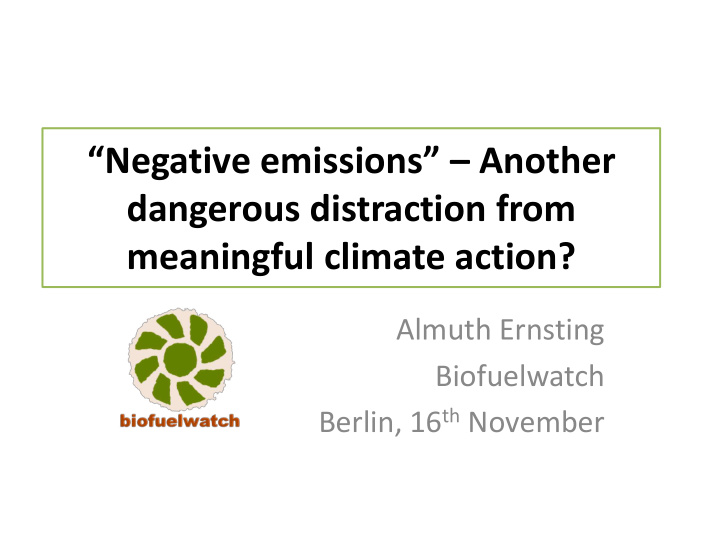



“Negative emissions” – Another dangerous distraction from meaningful climate action? Almuth Ernsting Biofuelwatch Berlin, 16 th November
Clearly the world would be a safer place with 350, not 400 ppm of CO 2 Increased energy of around 0.8 Watts per m 2 is yet to translate into global warming (‘energy imbalance’). “Sea level reached +6– 9 m in the Eemian, a time that we have concluded was probably no more than a few tenths of a degree warmer than Since 1750, human activities have today” (James Hansen et.al. 2016) changed the Earth’s energy balance (“radiative forcings ”) by around 2.29 Watts per m 2 (IPCC).
CO 2 sucking aliens would definitely be useful.... The question is whether “carbon negative” proposals are any more realistic
Bioenergy with Carbon Capture and Storage (BECCS): The IPCC’S favourite ‘carbon negative’ idea Ima
The three assumptions behind the concept of BECCS 1. Bioenergy is inherently carbon neutral; 2. CO 2 , once captured, can be safely stored forever; 3. The technologies needed to capture CO2 from bioenergy and to pump it underground are technically proven and will be economically viable in the near future.
Is bioenergy inherently carbon neutral? Wetland forest in North Carolina clearcut to make wood pellets for European power stations Photo: Dogwood Alliance Governments have no idea how to expand bioenergy whilst preventing even the worst- case scenarios of forest and peatland destruction.
What would an attempt to sequester 1 billion tonnes of carbon through BECCS look like? • 218-990 million hectares of land; • 17-79 million tonnes of fertiliser a year (75% of current global nitrogen fertiliser use); • 1.6-7.4 trillion cubic metres of water a year. Study by Lydia L. Smit and Margaret S. Torn, 2013
Carbon storage: Will CO2 remain where it’s pumped? • 3 million abandoned oil and gas wells in the US alone; • Many abandoned wells are not plugged, or their plugs are cracked; • Many of these wells penetrate deeper formations considered for CO2 sequestration; The biggest risk for CO2 leakage from geological • Sequestered CO2 turns reservoirs: Abandoned oil and gas wells trapped seawater acidic and can corrode cement Source: Huffington Post/DAVID MCNEW VIA GETTY plugs. IMAGES
Boundary Dam: The world’s only commercial - scale power station CCS project SaskPower opened the world’s first commercial-scale coal power unit with CO 2 capture in October 2014: • The carbon capture unit has never yet worked reliably; • Economically, it would never have been built without a contract to sell CO 2 for Enhanced Oil Recovery – and even then, the project wouldn’t have broken even over its lifetime, even Source: SaskPower without technical problems; • 30- 31% of the plant’s energy is For a biomass power station, the ‘energy used to capture and compress penalty’ of carbon capture would be higher CO 2. still.
Enhanced Oil Recovery: Bad for the climate, yet essential for making CCS commercially viable Oil companies estimate that around 30% of CO 2 injected during Enhanced Oil Recovery goes directly back into the atmosphere Altogether 0.7 million tonnes of CO 2 captured and Boundary Dam may stay under ground – but 1.5 million tonnes will have been emitted as a result of CCS! Enhanced Oil Recovery allows oil to be squeezed from depleted fields which could not otherwise be recovered.
The most ‘advanced’ BECCS concept, never tried yet Wikipedia diagram of an Integrated Gas Turbine Combined Cycle Plant without CCS Just add extra gas cleaning, a water-gas shift reactor, and CO2 compression and.... What could possibly go wrong?!
Some other bad ideas.... Photomontage of how Carbon Engineering Iron dumping in the Pacific Ocean want to capture CO2 from the atmosphere in 2012 , claimed to sequester carbon through algal blooms (largely outlawed by UN now)
Rebranding plantations.... “Carbon sink” tree plantation in Western Australia “Being perennial, oil palm plantations is a “Afforestation” is the ‘huge carbon sink’; cleaning up the atmosphere from carbon dioxide around the second main ‘negative clock !” = Malaysian Palm Oil Council emissions’ technology according to the IPCC
The only proven means for drawing down any CO 2
Conclusion • Only natural ecosystems are capable of drawing any CO2 down from the atmosphere; • Negative emissions technologies are sci-fi technologies. • The my of ‘negative emissions’ diverts attention from the desperate need to stop burning fossil fuels and destroying more ecosystems and biodiversity.
Recommend
More recommend